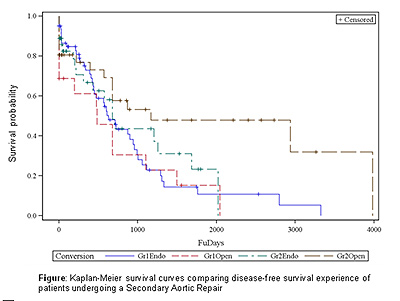Back to Annual Meeting Program
Survival Comparison of Patients undergoing Secondary Aortic Repair
Dean J Yamaguchi, Marjan Mujib, Thomas C Matthews, Marc A Passman, Mark A Patterson, Steve M Taylor, Bruce G Lowman, Bart R Combs, William D Jordan, Jr.
University of Alabama at Birmingham, Birmingham, AL
INTRODUCTION:
Infrarenal abdominal aortic aneurysm (AAA) repair requires lifelong surveillance due to continued disease. The outcome of a second aortic intervention may further be affected by therapeutic approach. In the current study, we evaluated outcomes in patients who underwent secondary aortic procedures after initial aortic repair, either EVAR or open.
Methods: Patients who underwent open repair (N=1012) or EVAR (N=1244) between 1986 and 2011 were identified in the vascular surgery database. Within this population, we identified patients who subsequently underwent a secondary aortic intervention (N=149), either open or endovascular. Chi-squared data analysis was then performed utilizing SAS, and Kaplan-Meier survival curves were calculated.
Results: During a 25-year study period, 2256 abdominal aneurysm repairs were performed with 149 patients (6.6%) requiring secondary aortic procedures. Of these 149 patients, 77 (51.7%) underwent initial EVAR (Group 1) while 72 patients (48.3%) underwent open AAA repair (Group 2). Sixty-one Group 1 patients (79.3%) (61/77) underwent secondary EVAR while 16 patients (20.7%) had a secondary open aortic procedure performed. Group 2 patients were evenly distributed between EVAR (36) or open (36) secondary repair. Group 1 one-year mortality was 15.6% (12/77) while Group 2 one-year mortality was 25.0% (18/72). One-year mortality for Group 1 patients who underwent secondary EVAR was 16.4% (10/61) and 12.5% (2/16) for those who underwent secondary open repair. Amongst Group 2 patients, secondary EVAR resulted in a one-year mortality of 27.8% (10/36) while that for patients who underwent secondary open repairs was 22.2% (8/36). Kaplan-Meier plots illustrated greater short-term (<1 year follow-up) survival for patients who underwent EVAR followed by secondary open aortic intervention. However, long-term (>1 year follow-up) survival was best for Group 2 patients after secondary open aortic interventions.
Conclusion: Patients who underwent initial EVAR followed by a second aortic procedure had lower one-year mortality than those who had open repair. Furthermore, secondary open aortic intervention after initial EVAR was associated with reduced one-year mortality compared with secondary aortic procedures, either endovascular or open, undertaken after initial open repair. These data suggest a preference for initial EVAR approach to infrarenal aortic aneurysms given the associated lower short-term mortality in patients who require secondary aortic intervention.

Back to Annual Meeting Program
